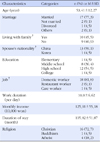Abstract
Purpose
This study was to explore situations that might put the middle-aged Korean-Chinese female migrant workers at risk for work-related musculoskeletal diseases (WMSDs). At the development phase of a continuing health project, the study aimed to clarify health promotion program needs of the migrant population.
Methods
A qualitative description research design was used with three focus groups of 23 Korean-Chinese female migrant workers. Each focus group interview was conducted for 70-minutes using semi-structured interview guidelines. The data were analyzed using directed qualitative content analysis techniques.
Results
The majority of the participants were household workers and their work included heavy material handling, standing for a long time, and working in awkward postures. They experienced discrimination from employers, lack of control at work, limitations in open-communication, job insecurity, and acculturation. They had needs to have health promotion programs for preventing and managing chronic diseases, depression and menopause as well as WMSDs.
Conclusion
The participants were situated in work environments with physical demanding tasks, acculturative and job-related stress and lack of opportunities to participate in health promotion programs. It is suggested to develop a comprehensive program to better meet the needs of middle-aged Korean-Chinese female migrant workers rather than targeting the reduction of WMSDs.
Figures and Tables
References
1. Berry JW. Sam DL, Berry JW, editors. Contexts of acculturation. The Cambridge handbook of acculturation psychology. 2006. New York: Cambridge.

2. Choi EJ, Yoo JS, Kim HS, Oh EG, Kim S, Bae SH. Utilization and needs assessment of health promotion programs for middle-aged women in public health centers. J Korean Acad Public Health Nurs. 2007. 21(2):193–205.
3. Chyuan JA, Du C, Yeh W, Li C. Musculoskeletal disorders in hotel restaurant workers. Occup Med (Lond). 2004. 54(1):55–57.

4. Choi CB. Legalized long term residence of Chosun-jok domestic workers. Dong-A Ilbo. 2010. 04. 24. Retrieved May 7, 2012. from http://news.donga.com/Society/3/03/20100424/27800417/1&top=1.
5. Cui J. A qualitative study on adjustment and the pattern of Korean-Chinese women in international marriage. Womens Stud Forum. 2007. 72(1):143–188.
6. Domestic Workers United & Datacenter. Home is where the work is: Inside New York's domestic work industry. 2006. Retrieved September 3, 2012. from http://www.datacenter.org/wp-content/uploads/homeiswheretheworkis.pdf.
7. Gaydos M, Hoover C, Lynch JE, Weintraub JM, Bhatia R. Health impact assessment of California assembly bill 889: The California domestic work employee equality, fairness, and dignity act of 2011. 2011. Retrieved September 3, 2012. from http://www.sfphes.org/Work_DWHIA.htm.
8. Hsieh HF, Shannon SE. Three approaches to qualitative content analysis. Qual Health Res. 2005. 15(9):1277–1288.

9. Jayaraman S, Dropkin J, Siby S, Alston LR, Markowitz S. Dangerous dining: Health and safety in the New York city restaurant industry. J Occup Environ Med. 2011. 53(12):1418–1424.
10. Jo MH, Kim KS, Lee SW, Kim TG, Ryu HW, Lee MY, et al. The relationship between job stress and musculoskeletal symptoms in migrant workers. Korean J Occup Environ Med. 2009. 21(4):378–387.

11. Kim SJ, Lee HK, Ahn HM. Relationship between work-related psychosocial and acculturative factors andwork-related musculoskeletal disorders among Korea-Chinese migrant workers living in Korea. Korean J Occup Health Nurs. 2010. 19(1):28–40.
12. Kim YH, Ha EH, Shin SJ. A study on the menopausal symptoms and quality of life in middle aged women. J Korean Acad Nurs. 2003. 33(5):601–608.

13. Korea Immigration Service. Korea immigration service annual statistics, year 2011. 2012. 07. Retrieved August 2, 2012. from http://www.immigration.go.kr/HP/COM/bbs_003/ListShowData.do?strNbodCd=noti0096&strWrtNo=123&strAnsNo=A&strOrgGbnCd=104000&strRtnURL=IMM_6050&strAllOrgYn=N&strThisPage=1&strFilePath=imm/.
14. Krueger RA, Casey MA. Focus groups: A practical guide for applied research. 2009. London: Sage Publications, Inc.
15. Lee HK, Ahn HM, Miller A, Park CG, Kim SJ. Acculturative stress, work-related psychosocial factors and depression in Korean-Chinese migrant workers in Korea. J Occup Health. 2012. 54(3):206–214.

16. Lee HK, Ahn HM, Park CG, Kim SJ, Moon SH. Psychosocial factors and work-related musculoskeletal disorders among Southeastern Asian female workers living in Korea. Saf Health Work. 2011. 2(2):183–193.

17. Lee HK, Chae DH, Lee KE, Lee MH. Application of community-based participatory research principles: Preventing work-related musculoskeletal disorders among female Korean-Chinese migrant workers in Korea. Workplace Health Saf. 2012. 60(7):313.

18. Lee JY. Domestic work experience of Korean-Chinese female migrants in Korea. 2004. Seoul: Yonsei University;Unpublished master's thesis.
19. Lee SY, Hong GS, Son YK. Living as a Chosun-jok aunt in Korea: Hermeneutical phenominological analysis of the life experience of Chosun-jok female domestic worker. J Korean Home Manage Assoc. 2010. 28(1):25–36.
20. Lee SW, Kim KS, Kim TW. The status and characteristics of industrial accidents for migrant workers in Korea compared with native workers. Korean J Occup Environ Med. 2008. 20(4):351–361.

21. Ministry of Employment and Labor. Current Statistics of Occupational Injuries and Illnesses, 2011. 2012. 02. Retrieved May 7, 2012. from http://www.moel.go.kr/view.jsp?cate=3&sec=2&mode=view&bbs_cd=3&bbs_cd=105&state=A&seq=1329702958686.
22. Ministry of Health and Welfare. Korea national health and nutrition survey, year 2010. 2011. 12. Retrieved October 11, 2012. from http://knhanes.cdc.go.kr/knhanes/index.do.
23. Sandelowski M. Focus on research methods-whatever happened to qualitative description? Res Nurs Health. 2000. 23(4):334–340.
24. Seol DH. Survey for the current status of migrant workers and their need from supporting services. 2003. Seoul: Korea International Labor Foundation.
25. Shiue H, Lu C, Chen C, Shih T, Wu S, Yang C, et al. Musculoskeletal disorder among 52,261 Chinese restaurant cooks cohort: Result from the national health insurance data. J Occup Health. 2008. 50(2):163–168.

26. Sullivan-Bolyai S, Bova C, Harper D. Developing and refining interventions in persons with health disparities: The use of qualitative description. Nurs Outlook. 2005. 53(3):127–133.

27. U.S. Bureau of Labor Statistics. Nonfatal occupational injuries and illness requiring days from work, 2010. 2011. Retrieved September 3, 2012. from http://www.bls.gov/iif/oshcdnew.htm.
28. Wadsworth E, Dhillon K, Shaw C, Bhui K, Stansfeld S, Smith A. Racial discrimination, ethnicity and work stress. Occup Med (Lond). 2007. 57(1):18–24.

29. Yi KH, Cho HH. The survey study on working conditions and industrial safety & health of foreign workers. J Korea Saf Manag Sci. 2012. 14(1):53–63.




 PDF
PDF ePub
ePub Citation
Citation Print
Print



 XML Download
XML Download